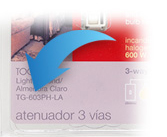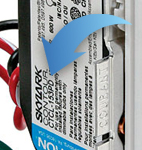
Explore Knowledge Articles
Back
Sunnata Dimmers and Companion Dimmers


Blink Codes for System Sunnata Devices
Sunnata Dimmers and Companion Dimmers
Note: Indicator lights are numerically ordered from bottom to top.
Example: Indicator light "1" is the bottom LED, indicator light "9" is the top LED.
Symptom:
- Main dimmer: LEDs 6, 8, and 9 are flashing slowly (once per second).
- Some companions: LEDs 1, 2, and 4 are flashing quickly (three times per second).
- Other companions: LEDs 7, 8, and 9 are flashing slowly (once per second) or no LEDs are illuminated.
Cause:
- One or more companion dimmers are on the load side of the main dimmer. Main dimmer must be on the load side of the circuit.
Action:
- Swap the main dimmer with a companion dimmer that has LEDs 1, 2, and 4 flashing quickly (three times per second).
Symptom:
- Main dimmer: LEDs 1,7, and 9 are flashing.
- Companion: No LEDs illuminated.
Cause:
- Wiring error.
Action:
- Swap wires on black and brass terminals on the main dimmer.
- Ensure wiring matches wiring diagrams.
Symptom:
- Main dimmer: LEDs 7, 8, and 9 are flashing.
- Companion: No LEDs illuminated.
Cause:
- Wiring error.
Action:
- Swap wires on blue and brass terminals on the main dimmer.
- Ensure wiring matches wiring diagrams.
Symptom:
- Main dimmer: LEDs 1 and 7 are flashing.
- Companion: No LEDs illuminated.
Cause:
- Improper phase selection.
- Incoming line voltage is too high.
Action:
- Change to forward-phase. Confirm load compatibility in Step 2 and use instructions in Step 7 / Phase-Select Mode to change phase.
- Ensure that the input voltage to the device is less than 130 V~.
Symptom:
- Main dimmer: LEDs 1, 2, and 3 are flashing.
- Companion: No LEDs illuminated.
Cause:
- Incompatible load.
- Hot and neutral connections are reversed.
- Potential short detected
Action:
- Check if lamp is compatible on www.lutron.com/ledfinder. Change to a compatible lamp.
- Swap wires on the black and silver terminals.
- Remove the load and leave the Hot and Neutral connected. When power is restored, if the blink code returns, contact Lutron Technical Support.
- As an alternative, swap with a known working dimmer; if working dimmer displays the code, refer to Action 1.
Symptom:
- Main dimmer: LED 5 is flashing.
- Companion: No LEDs illuminated.
Cause:
- Load or ambient temperature exceeds ratings.
Action:
- Ensure load is within ratings. See Step 2 of the installation guide or refer to "Sunnata PRO Dimmers & Switches".
- Note deratings for multi-gang applications.
- Ensure ambient temperature is less than 104 °F ( 40 °C).
- Pull FASS and replace. See Step 6 of the installation guide.
Symptom:
- Main dimmer: LEDs 1-9 are flashing.
- Companion: No LEDs illuminated.
Cause:
- Wiring issue at main dimmer.
- Wiring issue at load or load failure.
- Improper phase selection.
- Incompatible load.
Action:
- Swap wires on the silver and brass terminals on the main dimmer.
- Check wiring at all the terminals.
- Check for short circuits to neutral or ground in all wiring locations, including at the load.
- Remove load and check if it failed as a short.
- Change phase. Confirm load compatibility in Step 2 and use instructions in Step 7 / Phase-Select Mode to change phase.
- Check if lamp is compatible on www.lutron.com/ledfinder. Change to compatible lamp.
Sunnata Switches
Symptom:
- Switch Status LED flashes 4 times every 5 seconds
Cause:
- Wiring error
Action:
- Swap wires on blue and brass terminals on the main switch.
- Ensure wiring matches wiring diagrams.
Symptom:
- Status LED flashes 2 times every 5 seconds
Cause:
- Load or ambient temperature exceeds ratings.
Action:
- Ensure load is within ratings. See Step 2 of the installation guide or refer to "Sunnata PRO Dimmers & Switches".
- Note deratings for multi-gang applications.
- Ensure ambient temperature is less than 104 °F ( 40 °C).
- Pull FASS out and push back in. See Step 6 of the installation guide.
Standard Sunnata Keypads
Symptom:
- Status LEDs on the keypad don’t light up when buttons on it are pressed.
Cause:
- Power is not present at the keypad.
- Incorrect wiring.
Action:
- Circuit breaker OFF. Turn ON breaker.
- Wire the keypad according to the installation section.
Symptom:
- All status LEDs on the keypad flash when any button is pressed.
Cause:
- The keypad is in the Factory Settings Mode and has not been configured to work in a system.
Action
- Refer to the RadioRa3 programming software and ensure the device is assigned to that keypad. Perform a transfer and make sure it is successful.
Hybrid Sunnata Keypads
The diagrams below show which LEDs are referred to in the troubleshooting steps.
Symptom:
- LED A blinks once per second and LED B is off (or dimly lit).
Cause:
- Hybrid keypad is detecting a wiring error.
Action:
- Check the wiring against Step 3 of the instructions. Verify that the black and red wires are not swapped.
Symptom:
- LED A and LED B are flashing alternatively, once per second.
Cause:
- Hybrid keypad is seeing higher voltage than expected.
Action:
- Change between forward-phase and reverse-phase. Refer to Step 7 "Phase-Select Mode" of the installation guide.
- Ensure that the input voltage to the device is less than 130V~.
Symptom:
- LED A flashes once per second, LED B stays on.
Cause:
- Hybrid keypad is detecting a problem with the circuit.
Action:
- Verify that the bulb is dimmable. Test with an incandescent/halogen bulb. Check compatibility on www.lutron.com/ledfinder.
- Check the wiring against Step 3 of the instructions. Verify that the black and white wires are not swapped.
- Test on another lighting circuit.
Symptom:
- LED A and LED B are flashing together, once per second.
Cause:
- Hybrid keypad has exceeded its rated temperature.
Action:
- Ensure load is within ratings noted in Step 2 of the install guide. Note derating for multi-gang applications.
- Ensure ambient temperature is less than 104°F (40°C).
Symptom:
- LED A stays on, LED B blinks once a second.
Cause:
- Hybrid keypad is seeing higher current than expected.
Action:
- Check the wiring against Step 3 of the instructions. Verify that the white and red wires are not swapped.
- Check the short circuits to neutral and ground in all wiring locations, including at the load.
- Replace the load(s) to check if it failed as a short.
- Change between forward-phase and reverse-phase. Refer to the instructions under Setup for phase selection.
- Check if bulb is compatible on www.lutron.com/ledfinder. Change to compatible bulb.
Symptom:
- Status LEDs on the keypad don’t light up when buttons on it are pressed.
Cause:
- Power not present at keypad.
- Incorrect wiring.
Action:
- Circuit breaker OFF. Turn ON the breaker.
- Check the wiring against Step 3 of the instructions.
Symptom:
- All status LEDs on the keypad flash when any button is pressed.
Cause:
- The keypad is in the Factory Settings Mode and has not been configured to work in a system.
Action:
- Refer to the programming software and ensure the device is assigned to that keypad. Perform a transfer and make sure it is successful.
Was this article helpful?
Thank you! We appreciate your feedback!


